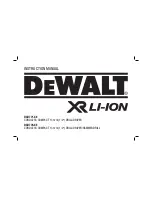
9
NOTE:
Continuous use in variable speed range is not recommended. It may damage
the switch and should be avoided.
Forward/Reverse Control Button (Fig. 2)
A forward/reverse control button (B) determines the direction of the tool and also
serves as a lock-off button.
To select forward rotation, release the trigger switch and depress the forward/reverse
control button on the right side of the tool.
To select reverse, depress the forward/reverse control button on the left side of the
tool.
The center position of the control button locks the tool in the off position. When
changing the position of the control button, be sure the trigger is released.
NOTE:
The first time the tool is run after changing the direction of rotation, you may
hear a click on start up. This is normal and does not indicate a problem.
Torque Adjustment Collar (Fig. 2)
Your tool has an adjustable torque screwdriver mechanism for driving and removing a
wide array of fastener shapes and sizes and in some models, a hammer mechanism
for drilling into masonry. Circling the collar (C) are numbers, a drill bit symbol, and in
some models, a hammer symbol. These numbers are used to set the clutch to deliver
a torque range. The higher the number on the collar, the higher the torque and the
larger the fastener which can be driven. To select any of the numbers, rotate until the
desired number aligns with the arrow.
Dual Range Gearing (Fig. 2)
The dual range feature of your drill/driver allows you to shift gears for greater
versatility.
1. To select speed 1 (high torque setting), turn the tool off and permit it to stop.
Slide the gear shifter (D) forward (towards the chuck).
2. To select speed 2 (low torque setting), turn the tool off and permit it to stop. Slide
the gear shifter back (away from the chuck).
NOTE:
Do not change gears when the tool is running. Always allow the drill to come
to a complete stop before changing gears. If you are having trouble changing gears,
make sure that the dual range gear shifter is either completely pushed forward or
completely pushed back.
Worklight (Fig. 2)
There is a worklight (E) located just above the trigger switch (A). The worklight is
activated when the trigger switch is depressed. When the trigger is released, the
worklight will stay illuminated for up to 20 seconds.
NOTE:
The worklight is for lighting the immediate work surface and is not intended to
be used as a flashlight.
Keyless Single Sleeve Chuck (Fig. 3–5)
WARNING:
Do not attempt to tighten drill bits (or any other accessory) by gripping
the front part of the chuck and turning the tool on. Damage to the chuck and personal
injury may result. Always lock off trigger switch and disconnect tool from power
source when changing acces sories.
FIG. 4
FIG. 5
F
FIG. 3
WARNING:
Always ensure the bit is secure before starting the tool. A loose bit may
eject from tool causing possible personal injury.
Your tool features a keyless chuck (F) with one rotating sleeve for one-handed
operation of the chuck. To insert a drill bit or other accessory, follow these steps.
1. Turn tool off and disconnect tool from power source.
2. Grasp the black sleeve of the chuck with one hand and use the other hand to
secure the tool. Rotate the sleeve counterclockwise far enough to accept the
desired accessory.
3. Insert the accessory about 19 mm (3/4") into the chuck and tighten securely by
rotating the chuck sleeve clockwise with one hand while holding the tool with
the other. Your tool is equipped with an automatic spindle lock mechanism. This
allows you to open and close the chuck with one hand.


































